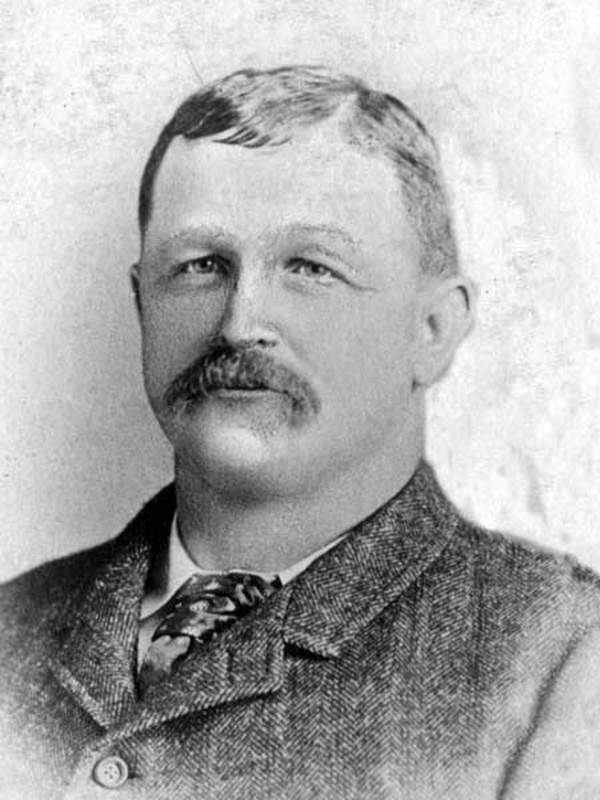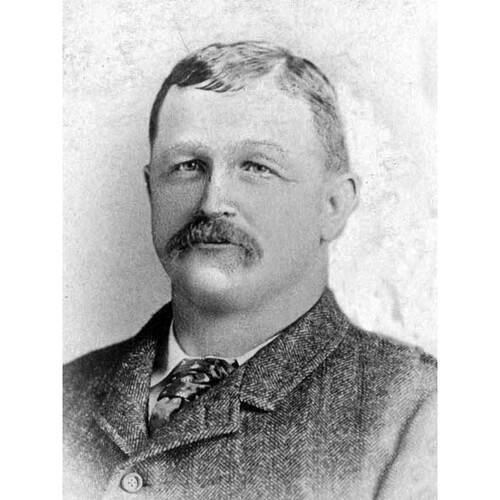
Source: Link
IRONSIDE, ROBERT, businessman, livestock breeder, and politician; b. November 1854 in London, Upper Canada, one of the eight children of William Ironside and Catherine Airth; m. November 1889 Annie Gordon, and they had two sons; d. 12 Oct. 1910 in Montreal.
Robert Ironside’s parents were both Presbyterian immigrants from Scotland who settled in London. He was educated in local common schools, and in 1883 he went to Manitou, Man., as an agent for John Elliott and Sons, a London manufacturer of agricultural implements.
By January 1885 Ironside had opened his own lumber, coal, and building material business in partnership with James Thomas Gordon. During the North-West rebellion of that year [see Louis Riel*], they supplied the army with beef. Before the end of 1885 the partnership of Ironside and Gordon had been dissolved, at least in Manitou. Ironside continued in business there and a short time later Gordon opened an establishment in Pilot Mound. During the next year Ironside added dealings in livestock to his operations in Manitou, as did Gordon in Pilot Mound. The two men seem to have retained some common commercial interests in Crystal City, where the firm of Gordon and Ironside, under the management of Charles Gordon, was selling lumber and buying hogs and cattle. In the autumn of 1886 Ironside sold his lumber and building material business at Manitou and announced his intention of “going into the Grain business for the winter.” He subsequently stated that he would relocate at La Rivière (about halfway between Manitou and Pilot Mound), where he was building a grain warehouse. By 1890 Ironside’s grain business was prospering, competing locally on equal terms with the province-wide operations of firms such as the Ogilvie Milling Company [see William Watson Ogilvie*].
The raising of cattle for export expanded in southern Manitoba after the building of a spur of the Canadian Pacific Railway to Pembina, N.Dak., provided the means of shipping animals to eastern Canada. Ironside began to purchase cattle and built up his own herds for export to Montreal. In the summer of 1890 the Manitou Mercury reported that Ironside and James Thomas Gordon were “scouring the countryside” for cattle. At what precise date this arrangement became the formal partnership of Gordon and Ironside is not clear. In August the two men shipped 300 steers to Montreal. Valued at $10,000, this shipment was the largest and most valuable yet made from southern Manitoba. Ironside himself accompanied the shipment east, and seems from this date to have been responsible for organizing the shipping end of the firm’s business. At least part of this shipment went on to England, and a later one of 318 head went via the Allan Line [see Sir Hugh Allan*] to Glasgow and Liverpool. Gordon and Ironside had entered the cattle-export business.
The import of Canadian cattle into the United Kingdom was slowed in 1896 by an embargo against any stock not destined for immediate slaughter. Nevertheless, Gordon and Ironside expanded their ranching facilities outside Manitoba by buying properties on the Red Deer, Little Bow, and South Saskatchewan rivers. They also leased grazing land on the Blood Indian Reserve (Alta) from the federal government. In addition to raising their own livestock the partners continued to buy from farmers and ranchers, including the British ranchers of Alberta, whose social style Ironside made no attempt to emulate. His interest was rather in shipping cattle, his maxim being “Just keep them moving along all the time – never let them stop.” Gordon and Ironside also sent cattle to South Africa, Switzerland, and France.
Shortly after the firm admitted a new partner, William H. Fares, to become Gordon, Ironside, and Fares in 1897, it incorporated and sold shares in what was then the largest livestock-exporting house in Canada. In 1900 the company shipped 50,000 head of cattle to England alone, almost half the total Canadian livestock exported to England in that year. Gordon, Ironside, and Fares was also involved in the meat trade, building on Logan Avenue in Winnipeg the largest and best-equipped abattoir west of St Paul, Minn., with a daily capacity of 250 cattle, 250 sheep, and 500 hogs. From this facility they supplied markets in central Canada, Manitoba, the North-West Territories, and British Columbia. Meat was transported to cold-storage plants by refrigerator cars. In 1896 Ironside moved to Montreal, where he took complete control of the export side of the business.
Before taking up residence in the province of Quebec, Ironside had become increasingly active in Manitoba politics. He had been elected to represent Manitou in the Legislative Assembly as a Liberal in the general election of July 1892, running on a platform of better roads, more railways, prohibition, and a school system that was both “national” and “secular.” He did not stand again in 1896, but flirted with the idea of contesting the federal riding of Lisgar. Liberal premier Thomas Greenway fully supported Ironside’s candidacy and expressed his willingness to help in any way possible. In spite of a full campaign chest, his federal pretensions were ended by his inability to leave Montreal for electioneering in the riding and by the emergence of Gordon as the Conservative candidate. Ironside withdrew rather than face the complications of political competition with his business partner.
He did not attempt to enter the political life of Quebec, although he did serve on the Montreal Board of Trade. He prospered in that city not only through his business but also by investing shrewdly in real estate. Contemporaries obviously did not think of him as a Montreal businessman. Although between his years in Manitou and Montreal he had lived only briefly in Winnipeg, on Mayfair Avenue, the Canadian annual review for 1910 reported his death as that of a “Winnipeg millionaire.”
AC, Montréal, État civil, Presbytériens, Erskine Presbyterian Church (Montreal), 14 Oct. 1910. NA, RG 31, C1, 1891, South Dufferin. PAM, GR 1662. Manitoba Morning Free Press, 13 Oct. 1910. Manitou Mercury (Manitou, Man.), 23 Jan., 27 Nov. 1885; 22, 29 Jan., 4 May, 17 Sept., 22 Oct., 26 Nov. 1886; 2 Nov. 1889; 2 Aug., 12 April, 6, 13 Sept. 1890; 17 May–25 July 1892. Winnipeg Tribune, 12 Oct. 1910. Bryce, Hist. of Man. Canadian annual rev. (Hopkins), 1910. Newspaper reference book. F. H. Schofield, The story of Manitoba (3v., Winnipeg, 1913).
Cite This Article
Wendy Owen, “IRONSIDE, ROBERT,” in Dictionary of Canadian Biography, vol. 13, University of Toronto/Université Laval, 2003–, accessed December 30, 2025, https://www.biographi.ca/en/bio/ironside_robert_13E.html.
The citation above shows the format for footnotes and endnotes according to the Chicago manual of style (16th edition). Information to be used in other citation formats:
| Permalink: | https://www.biographi.ca/en/bio/ironside_robert_13E.html |
| Author of Article: | Wendy Owen |
| Title of Article: | IRONSIDE, ROBERT |
| Publication Name: | Dictionary of Canadian Biography, vol. 13 |
| Publisher: | University of Toronto/Université Laval |
| Year of publication: | 1994 |
| Year of revision: | 1994 |
| Access Date: | December 30, 2025 |



